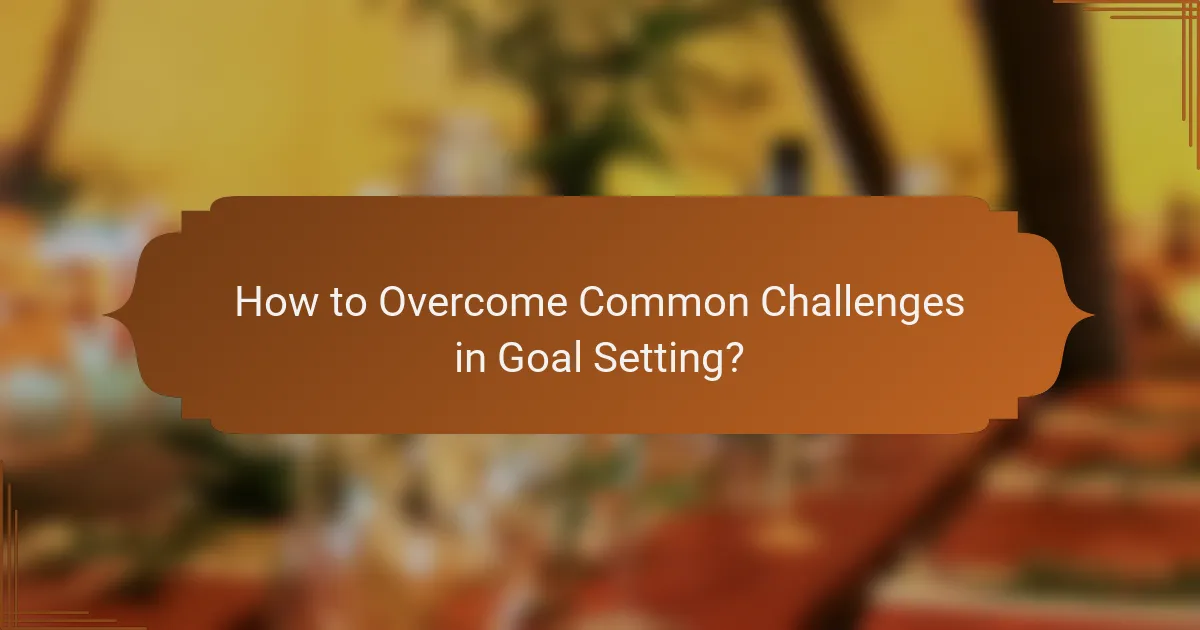Goal setting for couples is a powerful way to align visions and values, fostering a deeper emotional connection and mutual understanding. By engaging in open communication and collaboration, partners can establish shared priorities and create a clear roadmap for their future together. Utilizing various tools can enhance this process, ensuring accountability and organization as they work towards common objectives.

How Can Couples Set Effective Goals Together?
Couples can set effective goals together by aligning their visions and values through open communication and collaboration. This process involves establishing shared priorities, creating visual representations of their goals, and regularly reviewing their progress.
Establishing shared values
Establishing shared values is crucial for couples to set effective goals. Begin by discussing what matters most to each partner, such as family, career, health, or personal growth. This conversation helps identify common ground and ensures that both partners are working towards goals that reflect their collective beliefs.
Consider creating a list of values and ranking them in order of importance. This can serve as a foundation for future goal-setting discussions and help avoid conflicts that arise from differing priorities.
Creating a vision board
A vision board is a powerful tool for couples to visualize their shared goals. It can include images, quotes, and symbols that represent what both partners aspire to achieve together. This tangible representation serves as a daily reminder of their objectives and keeps motivation high.
To create a vision board, gather materials such as magazines, scissors, glue, and a poster board. Set aside time to collaborate on selecting images and words that resonate with both partners’ aspirations, ensuring that the final product reflects their unified vision.
Regular goal-setting meetings
Regular goal-setting meetings are essential for maintaining alignment and accountability. Schedule these meetings monthly or quarterly to review progress, discuss challenges, and adjust goals as needed. Consistent communication fosters a supportive environment where both partners feel heard and valued.
During these meetings, use a structured format to discuss each goal, evaluate progress, and celebrate achievements. This approach not only strengthens the partnership but also reinforces commitment to shared objectives.
Utilizing goal-setting apps
Goal-setting apps can enhance the process of tracking and managing shared goals. Many apps allow couples to set, monitor, and update their objectives in real-time, making it easier to stay organized and accountable. Look for apps that offer features like reminders, progress tracking, and collaborative tools.
Some popular options include Trello, Todoist, and Google Keep. Choose an app that both partners find user-friendly and compatible with their lifestyle to maximize its effectiveness.
Defining individual and joint goals
Defining both individual and joint goals helps couples balance personal aspirations with shared objectives. Each partner should identify personal goals that contribute to their growth while also discussing goals that strengthen the relationship and align with their shared values.
Consider categorizing goals into short-term and long-term, and ensure that both types are represented. This balance allows each partner to pursue personal interests while fostering a sense of teamwork in achieving common goals.

What Are the Benefits of Goal Setting for Couples?
Goal setting for couples fosters a shared vision and strengthens the relationship by providing clarity and direction. It encourages partners to work together towards common objectives, enhancing their emotional connection and mutual understanding.
Improved communication
Setting goals together requires open dialogue about desires, expectations, and concerns. This process helps couples articulate their thoughts and feelings, leading to better understanding and fewer misunderstandings. Regular check-ins on progress can further enhance this communication.
To facilitate effective communication, consider scheduling regular meetings to discuss goals. Use these sessions to express feelings and adjust plans as needed, ensuring both partners feel heard and valued.
Enhanced relationship satisfaction
When couples work towards shared goals, they often experience increased satisfaction in their relationship. Achieving milestones together can create a sense of accomplishment and strengthen the bond between partners. Celebrating these achievements reinforces positive feelings and commitment.
Consider setting both short-term and long-term goals to maintain motivation. For example, planning a weekend getaway can serve as a short-term goal, while saving for a home can be a long-term objective. Each success contributes to overall relationship happiness.
Increased accountability
Goal setting establishes a framework for accountability, as partners can support each other in achieving their objectives. This mutual responsibility encourages both individuals to stay committed and focused on their shared vision. It also fosters trust and reliability within the relationship.
To enhance accountability, create a shared document or use an app to track progress. Regularly review each other’s contributions and offer encouragement, which can help maintain motivation and commitment to the goals.
Alignment of life priorities
Setting goals together helps couples align their life priorities, ensuring that both partners are on the same page regarding their future. This alignment can prevent conflicts and promote harmony, as both individuals work towards a common vision.
To achieve alignment, discuss individual values and aspirations openly. Identify areas of overlap and create goals that reflect both partners’ priorities. This collaborative approach can lead to a more fulfilling and harmonious partnership.

What Tools Can Help Couples in Goal Setting?
Couples can enhance their goal-setting process by utilizing various tools designed to align their visions and values. These tools facilitate communication, organization, and accountability, making it easier for partners to work together towards shared objectives.
Couples goal-setting worksheets
Goal-setting worksheets specifically designed for couples provide a structured way to outline and discuss individual and shared goals. These worksheets typically include sections for personal aspirations, relationship objectives, and action plans, helping partners clarify their visions.
When using worksheets, couples should set aside dedicated time to fill them out together, ensuring open dialogue about each person’s priorities. This collaborative effort can strengthen understanding and commitment to mutual goals.
Apps like Trello and Asana
Project management apps such as Trello and Asana can be effective for couples looking to track their goals. These platforms allow users to create boards or lists for different goals, assign tasks, and set deadlines, promoting accountability and progress tracking.
Couples should choose an app that suits their workflow and preferences, whether they prefer a visual layout or a more traditional task list. Regular check-ins using these apps can help maintain focus and motivation as partners work towards their goals together.
Books on relationship goals
Reading books focused on relationship goals can provide valuable insights and strategies for couples. Titles that explore communication, shared values, and goal alignment can inspire partners to reflect on their aspirations and how they can support each other.
Couples should consider selecting a book that resonates with their current stage in the relationship and encourages discussion. Setting aside time to read and discuss key takeaways can deepen understanding and foster a shared commitment to achieving their goals.

How to Overcome Common Challenges in Goal Setting?
Overcoming common challenges in goal setting requires open communication and a willingness to compromise. Couples must recognize their individual priorities and work collaboratively to align their visions and values.
Addressing differing priorities
When couples have differing priorities, it’s crucial to openly discuss what each person values most. This conversation can help identify common ground and areas of compromise. For example, if one partner prioritizes career advancement while the other values family time, they might agree to set specific work hours that allow for family activities.
Creating a shared list of priorities can also be beneficial. Couples can rank their goals and identify which ones are most important to each person, helping to clarify where they can align their efforts.
Managing time constraints
Time constraints can hinder effective goal setting. Couples should assess their schedules and identify time blocks dedicated to working on shared goals. This might mean setting aside one evening a week for planning or dedicating a weekend morning to review progress.
Using tools like shared calendars or goal-tracking apps can help couples stay organized and accountable. Regular check-ins can ensure that both partners are on the same page and can adjust their commitments as needed.
Resolving conflicts in goal alignment
Conflicts in goal alignment often arise from misunderstandings or differing expectations. Couples should approach these conflicts with empathy and a focus on finding solutions. Discussing the reasons behind each partner’s goals can foster understanding and lead to more effective compromises.
Establishing a conflict resolution strategy can also be helpful. For instance, couples might agree to take a break if discussions become heated, returning to the conversation with a clearer mindset. This approach can prevent escalation and promote a more constructive dialogue.
